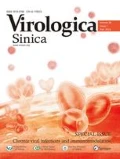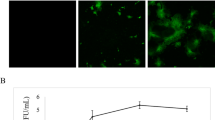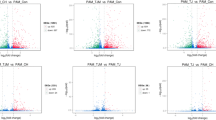Abstract
Porcine reproductive and respiratory syndrome virus (PRRSV) causes substantial economic losses to the global pig industry. Alternative polyadenylation (APA) is a mechanism that diversifies gene expression, which is important for tumorigenesis, development, and cell differentiation. However, it is unclear whether APA plays a role in the course of PRRSV infection. To address this issue, in this study we carried out a whole-genome transcriptome analysis of PRRSV-infected Marc-145 African green monkey kidney cells and identified 185 APA switching genes and 393 differentially expressed genes (DEGs). Most of these genes were involved in cellular process, metabolism, and biological regulation, and there was some overlap between the two gene sets. DEGs were found to be more directly involved in the antiviral response than APA genes. These findings provide insight into the dynamics of host gene regulation during PRRSV infection and a basis for elucidating the pathogenesis of PRRSV.





Similar content being viewed by others
References
Allende R, Lewis TL, Lu Z, Rock DL, Kutish GF, Ali A, Doster AR, Osorio FA (1999) North American and European porcine reproductive and respiratory syndrome viruses differ in non-structural protein coding regions. J Gen Virol 80:307–315
Butler JE, Lager KM, Golde W, Faaberg KS, Sinkora M, Loving C, Zhang YI (2014) Porcine reproductive and respiratory syndrome (PRRS): an immune dysregulatory pandemic. Immunol Res 59:81–108
Cancel-Tirado SM, Evans RB, Yoon KJ (2004) Monoclonal antibody analysis of porcine reproductive and respiratory syndrome virus epitopes associated with antibody-dependent enhancement and neutralization of virus infection. Vet Immunol Immunopathol 102:249–262
Cavanagh D (1997) Nidovirales: a new order comprising Coronaviridae and Arteriviridae. Arch Virol 142:629–633
Chia MY, Hsiao SH, Chan HT, Do YY, Huang PL, Chang HW, Tsai YC, Lin CM, Pang VF, Jeng CR (2010) The immunogenicity of DNA constructs co-expressing GP5 and M proteins of porcine reproductive and respiratory syndrome virus conjugated by GPGP linker in pigs. Vet Microbiol 146:189–199
Collins JE, Benfield DA, Christianson WT, Harris L, Hennings JC, Shaw DP, Goyal SM, McCullough S, Morrison RB, Joo HS, Et A (1992) Isolation of swine infertility and respiratory syndrome virus (isolate ATCC VR-2332) in North America and experimental reproduction of the disease in gnotobiotic pigs. J Vet Diagn Investig 4:117–126
Danckwardt S, Gantzert AS, Macher-Goeppinger S, Probst HC, Gentzel M, Wilm M, Grone HJ, Schirmacher P, Hentze MW, Kulozik AE (2011) p38 MAPK controls prothrombin expression by regulated RNA 3′ end processing. Mol Cell 41:298–310
Elkon R, Ugalde AP, Agami R (2013) Alternative cleavage and polyadenylation: extent, regulation and function. Nat Rev Genet 14:496–506
Fabian MR, Sonenberg N, Filipowicz W (2010) Regulation of mRNA translation and stability by microRNAs. Annu Rev Biochem 79:351–379
Fu Y, Sun Y, Li Y, Li J, Rao X, Chen C, Xu A (2011) Differential genome-wide profiling of tandem 3′ UTRs among human breast cancer and normal cells by high-throughput sequencing. Genome Res 21:741–747
Fu Y, Ge Y, Sun Y, Liang J, Wan L, Wu X, Xu A (2015) IVT-SAPAS: low-input and rapid method for sequencing alternative polyadenylation sites. PLoS ONE 10:e0145477
Hilgers V, Perry MW, Hendrix D, Stark A, Levine M, Haley B (2011) Neural-specific elongation of 3′ UTRs during Drosophila development. Proc Natl Acad Sci USA 108:15864–15869
Hopper SA, White ME, Twiddy N (1992) An outbreak of blue-eared pig disease (porcine reproductive and respiratory syndrome) in four pig herds in Great Britain. Vet Rec 131:140–144
Hoque M, Ji Z, Zheng D, Luo W, Li W, You B, Park JY, Yehia G, Tian B (2013) Analysis of alternative cleavage and polyadenylation by 3′ region extraction and deep sequencing. Nat Methods 10:133–139
Ji Z, Lee JY, Pan Z, Jiang B, Tian B (2009) Progressive lengthening of 3′ untranslated regions of mRNAs by alternative polyadenylation during mouse embryonic development. Proc Natl Acad Sci USA 106:7028–7033
Ji L, Zhou X, Liang W, Liu J, Liu B (2017) Porcine interferon stimulated gene 12a restricts porcine reproductive and respiratory syndrome virus replication in MARC-145 cells. Int J Mol Sci 18:1613
Jia X, Yuan S, Wang Y, Fu Y, Ge Y, Ge Y, Lan X, Feng Y, Qiu F, Li P, Chen S, Xu A (2017) The role of alternative polyadenylation in the antiviral innate immune response. Nat Commun 8:14605
Kappes MA, Faaberg KS (2015) PRRSV structure, replication and recombination: origin of phenotype and genotype diversity. Virology 479–480:475–486
Ke W, Fang L, Jing H, Tao R, Wang T, Li Y, Long S, Wang D, Xiao S (2017) Cholesterol 25-hydroxylase inhibits porcine reproductive and respiratory syndrome virus replication through enzyme activity-dependent and -independent mechanisms. J Virol 91:e00827-17
Li Y, Wu Z, Liu K, Qi P, Xu J, Wei J, Li B, Shao D, Shi Y, Qiu Y, Ma Z (2017) Proteomic analysis of the secretome of porcine alveolar macrophages infected with porcine reproductive and respiratory syndrome virus. Proteomics. https://doi.org/10.1002/pmic.201700080
Ma Z, Yang L, Zhang YJ (2018) Porcine reproductive and respiratory syndrome virus: propagation and quantification. Curr Protoc Microbiol 48:15M.1.1–15M.1.14
Mayr C, Bartel DP (2009) Widespread shortening of 3′UTRs by alternative cleavage and polyadenylation activates oncogenes in cancer cells. Cell 138:673–684
Proll MJ, Neuhoff C, Schellander K, Uddin MJ, Cinar MU, Sahadevan S, Qu X, Islam MA, Poirier M, Muller MA, Drosten C, Tesfaye D, Tholen E, Grosse-Brinkhaus C (2017) Transcriptome profile of lung dendritic cells after in vitro porcine reproductive and respiratory syndrome virus (PRRSV) infection. PLoS ONE 12:e0187735
Proudfoot NJ (2011) Ending the message: poly(A) signals then and now. Genes Dev 25:1770–1782
Rossow KD, Collins JE, Goyal SM, Nelson EA, Christopher-Hennings J, Benfield DA (1995) Pathogenesis of porcine reproductive and respiratory syndrome virus infection in gnotobiotic pigs. Vet Pathol 32:361–373
Sandberg R, Neilson JR, Sarma A, Sharp PA, Burge CB (2008) Proliferating cells express mRNAs with shortened 3′ untranslated regions and fewer microRNA target sites. Science 320:1643–1647
Schlackow M, Marguerat S, Proudfoot NJ, Bahler J, Erban R, Gullerova M (2013) Genome-wide analysis of poly(A) site selection in Schizosaccharomyces pombe. RNA 19:1617–1631
Shi Y (2012) Alternative polyadenylation: new insights from global analyses. RNA 18:2105–2117
Sun Y, Fu Y, Li Y, Xu A (2012) Genome-wide alternative polyadenylation in animals: insights from high-throughput technologies. J Mol Cell Biol 4:352–361
Takagaki Y, Seipelt RL, Peterson ML, Manley JL (1996) The polyadenylation factor CstF-64 regulates alternative processing of IgM heavy chain pre-mRNA during B cell differentiation. Cell 87:941–952
Tian B, Manley JL (2013) Alternative cleavage and polyadenylation: the long and short of it. Trends Biochem Sci 38:312–320
Tian B, Hu J, Zhang H, Lutz CS (2005) A large-scale analysis of mRNA polyadenylation of human and mouse genes. Nucleic Acids Res 33:201–212
Ulitsky I, Shkumatava A, Jan CH, Subtelny AO, Koppstein D, Bell GW, Sive H, Bartel DP (2012) Extensive alternative polyadenylation during zebrafish development. Genome Res 22:2054–2066
Zhao F, Fang L, Wang D, Song T, Wang T, Xin Y, Chen H, Xiao S (2016) SILAC-based quantitative proteomic analysis of secretome of Marc-145 cells infected with porcine reproductive and respiratory syndrome virus. Proteomics 16:2678–2687
Acknowledgements
This work was supported by the Natural Science Foundation of Guangdong Province (2014A030312011) and Guangzhou Science and Technology Plan (201804020039).
Author information
Authors and Affiliations
Contributions
YC, YW, JL and CX designed the study; YW performed the experiments; JL and YW analyzed the data; YW prepared the figures and tables; YW and YZ wrote the main manuscript. YC checked and finalized the manuscript. All authors read and approved the final manuscript.
Corresponding author
Ethics declarations
Conflict of interest
The authors declare that they have no conflict of interest.
Animal and Human Rights Statement
This article does not contain any studies with human or animal subjects performed by any of the authors.
Rights and permissions
About this article
Cite this article
Wei, Y., Li, J., Zhang, Y. et al. Tandem 3′ UTR Patterns and Gene Expression Profiles of Marc-145 Cells During PRRSV Infection. Virol. Sin. 33, 335–344 (2018). https://doi.org/10.1007/s12250-018-0045-y
Received:
Accepted:
Published:
Issue Date:
DOI: https://doi.org/10.1007/s12250-018-0045-y




